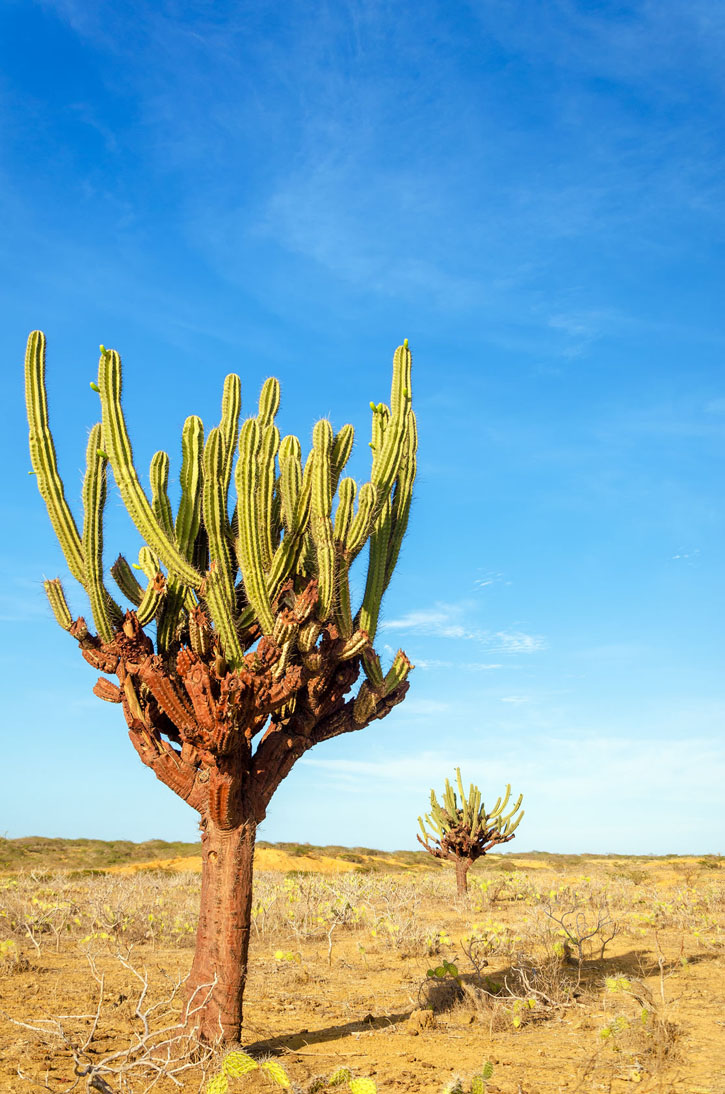The Alta Guajira (Upper Guajira) comprises the entire peninsula east of Cabo de la Vela and Uribia. It is very sparsely populated: The three largest settlements, where most of the tourism infrastructure is located, are Cabo de la Vela, Punta Gallinas at the very northern tip, and Nazareth, in the northeast. The terrain has a striking ochre color, with rocky and sandy patches. The vegetation is mostly shrubs and cacti. The Caribbean coast here is broken by three large bays with stunning turquoise and aquamarine waters: Bahía Portete, Bahía Honda, and Bahía Hondita. The last of these is easily accessible to tourists in day trips from Punta Gallinas. There are a few low mountain ranges, including the Serranía de la Macuira (864 meters/2,835 feet), located in the extreme northeastern corner of the peninsula, but overall the terrain is low and slightly undulated.

Be mesmerized by the stark beauty of desert landscapes, get to know Wayúu culture, and dine on fresh lobster at the top of South America in Alta Guajira, Photo © Jesse Kraft/123rf.
The only destination in the Alta Guajira that is accessible by public transportation is Cabo de la Vela. Though it is possible to contract transportation by land or sea to Punta Gallinas, most visitors opt to visit the region in an easily organized tour.
The sands of Alta Guajira are a favorite location for raucous 4×4 races and competitions. A large annual event is the Rally Aventura Guajira, which takes place in August, when more than 200 vehicles trek across the desert from Riohacha to Cabo de la Vela. If this isn’t your bag you may want to double-check your dates of travel to make sure they don’t coincide with the event.
The standard Alta Guajira tour involves going to Cabo de la Vela on day one, with a stop at the now-abandoned salt mines of the Salinas de Manaure (not worth a visit), spending the night at Cabo de la Vela, continuing on the next day to Punta Gallinas, and returning to Riohacha on day three (COP$340,000-380,000 per person, including food and lodging). A longer tour involves two additional nights in Nazareth to visit the Parque Natural Nacional Macuira (COP$800,000-880,000 per person, including food and lodging).
The desert countryside seems endless and is beautiful in its own desolate way.Make sure to check how many people are in your SUV, as there have been reports of tour operators who cram seven people into a vehicle, making for an uncomfortable ride. Tour guides generally have a limited grasp of English.The most comfortable option by far is to rent an SUV with a driver for your own party. This costs around COP$400,000 per day, not including food and lodging.
The desert countryside seems endless and is beautiful in its own desolate way. You’ll be amazed at how these drivers know which way to go, as there are no road signs, only cacti and occasional goats. Every once in a while, you will have to pay “tolls” to Wayúu children who have set up quasi road blocks. To gain their permission to cross, drivers hand over crackers, cookies, or candy.
Tour companies offer package tours or private vehicles. A highly recommended tour company is Expedición Guajira (Cl. 2 No. 5-06, tel. 5/727-2336, cell tel. 311/439-4677 or 301/464-2758), managed by Franklin Penalver. His guides, of Wayúu origin, know the area like the back of their hands.
Solera Travels (Cra. 9A No. 15-352, cell tel. 316/525-1295) has an office at the Castillo de Mar hostel and sells all the regular tour packages. Kaishi (Plaza Principal, Uribia, cell tel. 311/429-6315) is another agency that has a good reputation.
Excerpted from the First Edition of Moon Colombia.